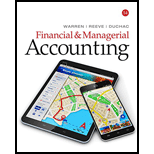
Concept explainers
Process activity analysis
The Brite Beverage Company hollies soft drinks into aluminum cans. The manufacturing process consists of three activities:
- 1. Mixing: water, sugar, and beverage concentrate are mixed.
- 2. Filling: mixed (leverage is filled into 12-oz. cans.
- 3. Packaging: properly filled cans are boxed into cardboard “fridge packs."
The activity costs associated with these activities for the period are as follows:
| Mixing | $216,000 |
| Filling | 168,000 |
| Packaging | 96,000 |
| Total | $480,000 |
The activity costs do not include materials costs, which are ignored for this anal) sis. Each can is expected to contain 12 ounces of beverage. Thus, after being filled, each can is automatically weighed. If a can is too light, it is rejected, or “kicked," from the filling line prior to being packaged. The primary cause of kicks is heat expansion. With heat expansion, the beverage overflows during filling, resulting in underweight cans.
This proce.ss begins by mixing and filling 6,300,000 cans during the period, of which only 6,000,000 cans are actually packaged. Three hundred thousand cans are rejected due to underweight kicks.
A process improvement team has determined that cooling the cans prior to filling them will reduce the amount of overflows due to expansion. After this improvement, the number of kicks is expected to decline from 300,000 cans to 63,000 cans, thus increasing the number of filled cans to 6,237,000 [6,000,000 + (300,000 – 63,000)].
- A. Determine the total activity cost per packaged can under present operations.
- B. Determine the amount of increased packaging activity costs from the expected improvements.
- C. Determine the expected total activity cost per packaged can after improvements. (Round to three decimal places.)
Want to see the full answer?
Check out a sample textbook solution
Chapter 26 Solutions
Financial & Managerial Accounting
- The following data relating to direct materials cost for October of the current year are taken from the records of Good Clean Fun Inc., a manufacturer of organic toys: Quantity of direct materials used 3,400 lbs. Actual unit price of direct materials $5.1 per lb. Units of finished product manufactured 820 units Standard direct materials per unit of finished product 4 lbs. Direct materials quantity variance-unfavorable $ 636 Direct materials price variance-favorable $ 680 Determine the standard direct materials cost per unit of the finished product, assuming that there was no inventory of work in process at either the beginning or the end of the month.arrow_forwardKindly help me with accounting questionsarrow_forwardHelp me tutor of account.arrow_forward
- provide this general accounting answerarrow_forwardNeed A EXPERT NOT AI The following facts perta lessee. a non-cancelable lease agreement between Splish Brothers Leasing Company and Sunland Company Commencement date May 1, 2025 Annual lease payment due at the beginning of each year, beginning with May 1, 2025 $20,456.70 Bargain purchase option price at end of lease term $4,000 Lease term 5 years Economic life of leased equipment 10 years Lessor's cost $65,000 Fair value of asset at May 1, 2025 $98.000.20 Lessor's implicit rate 4 % Lessee's incremental borrowing rate 4 % The collectibility of the lease…arrow_forwardNeed help with this accounting questionsarrow_forward
- Quick answer of this accounting questionsarrow_forwardGeneral Accountarrow_forwardNeed A EXPERT NOT AI The following facts perta lessee. a non-cancelable lease agreement between Splish Brothers Leasing Company and Sunland Company Commencement date May 1, 2025 Annual lease payment due at the beginning of each year, beginning with May 1, 2025 $20,456.70 Bargain purchase option price at end of lease term $4,000 Lease term 5 years Economic life of leased equipment 10 years Lessor's cost $65,000 Fair value of asset at May 1, 2025 $98.000.20 Lessor's implicit rate 4 % Lessee's incremental borrowing rate 4 % The collectibility of the lease…arrow_forward
- Recognizing Red Flags Refer to the article below, which was assigned as part of the reading for this week, about a $1.3 million fraud committed by an employee at the Fort Worth, Texas stockyard. This fraud is a stark example of what can happen, and for how long, when no one is looking for red flags. White Collar Crime: The criminal in the next cubicle. Respond to the following: Explain what happened in the case, how long the fraudulent lasted, who discovered the fraud and how, what the court decided, and what the consequences were for the stockyard. Describe some of the red flags and internal control procedures that should have been in place to deter the fraud. Support your answer. Be sure to respond to at least one of your classmates' posts.arrow_forwardCan you please solve this general accounting question?arrow_forwardNeed answer the general accounting questionarrow_forward
 Managerial AccountingAccountingISBN:9781337912020Author:Carl Warren, Ph.d. Cma William B. TaylerPublisher:South-Western College Pub
Managerial AccountingAccountingISBN:9781337912020Author:Carl Warren, Ph.d. Cma William B. TaylerPublisher:South-Western College Pub Financial And Managerial AccountingAccountingISBN:9781337902663Author:WARREN, Carl S.Publisher:Cengage Learning,
Financial And Managerial AccountingAccountingISBN:9781337902663Author:WARREN, Carl S.Publisher:Cengage Learning, Cornerstones of Cost Management (Cornerstones Ser...AccountingISBN:9781305970663Author:Don R. Hansen, Maryanne M. MowenPublisher:Cengage Learning
Cornerstones of Cost Management (Cornerstones Ser...AccountingISBN:9781305970663Author:Don R. Hansen, Maryanne M. MowenPublisher:Cengage Learning Essentials of Business Analytics (MindTap Course ...StatisticsISBN:9781305627734Author:Jeffrey D. Camm, James J. Cochran, Michael J. Fry, Jeffrey W. Ohlmann, David R. AndersonPublisher:Cengage LearningPrinciples of Accounting Volume 2AccountingISBN:9781947172609Author:OpenStaxPublisher:OpenStax College
Essentials of Business Analytics (MindTap Course ...StatisticsISBN:9781305627734Author:Jeffrey D. Camm, James J. Cochran, Michael J. Fry, Jeffrey W. Ohlmann, David R. AndersonPublisher:Cengage LearningPrinciples of Accounting Volume 2AccountingISBN:9781947172609Author:OpenStaxPublisher:OpenStax College Principles of Cost AccountingAccountingISBN:9781305087408Author:Edward J. Vanderbeck, Maria R. MitchellPublisher:Cengage Learning
Principles of Cost AccountingAccountingISBN:9781305087408Author:Edward J. Vanderbeck, Maria R. MitchellPublisher:Cengage Learning





